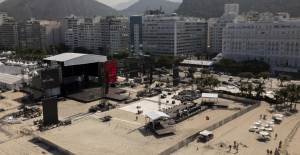In 2007, at the age of 97, Julien Gracq, author of the now classic Rivage des Syrtes, Un balcon en forêt and Carnets du grand chemin, died, works that can be found in the "Pléiade", where he had entered from his alive, which is exceptional. The author bequeathed all of his manuscripts to the National Library of France, from the autograph copies of his first novel, Au château d'Argol, published in 1938, to the still unpublished texts, some of which have since been published by its historic publisher, José Corti, under the titles Manuscripts of War (2011), Terres du couchant (2014), Knots of Life, seven years later, and, most recently, the superb story La Maison. We find there this particular gaze, this singular and charming tone, this "muffled, secret voice", as his former student, the novelist Jean-René Huguenin, said of whom Gracq had been the history-geography teacher at the Lycée Claude-Bernard. , in Paris.
From July 11, the BnF, from this listed and archived collection, will celebrate one of the most outstanding and remarkable figures of 20th century literature by presenting an exhibition on the François-Mitterrand site, in the gallery des Donateurs, open since 2010 and which previously paid tribute to Vladimir Jankélévitch, Roland Barthes or Pascal Quignard, whose entire body of work has just been crowned with the BnF literary prize. This exhibition, called "The Shape of a Work", inspired by the title of a book by Gracq, The Shape of a City (published in 1985), presents for the first time the manuscripts and documents bequeathed at his death, to through a hundred pieces. Moving testimonies of the making of a particularly demanding work, the literary manuscripts of Julien Gracq are exhibited alongside photographs, engravings, articles and even his school notebooks.
Personalities who have read or known Julien Gracq, born Louis Poirier in 1910, in Saint-Florent-le-Vieil, comment on certain pieces, thus allowing, according to the press release from the BnF, to discover or rediscover "a writer at the deviation from fashions, freed from the prescriptions of public opinion, which refused the 1951 Goncourt prize for Le Rivage des Syrtes and which has never accepted for his art only three imperatives: freedom, quality and integrity". Some very specific archives will not be able to reveal all their secrets until 2027: these are the thirty-five note books, totaling some 3,500 pages.
This unique journey in the work of Julien Gracq revolves around several themes: youth and training, geography, the conception of literature, and the great stories related to war. And, honor where credit is due, A balcony in the forest and Le Rivage des Syrtes are particularly highlighted. For Jérôme Villeminoz, curator of the exhibition, curator in the manuscripts department at the BnF, “these are the most imposing works, perhaps the most read, by Gracq; and the exhibition, for each of them, of the working version, the corrected copy and the clean-up makes it possible to understand Gracq's way of writing, of entering his kitchen”.
Jérôme Villeminoz specifies: “This is not an exegetical and scholarly exhibition, rather an introduction to Gracq through his manuscripts. It is a question, while thanking him for the immense gift which he granted to the BnF, of respecting the way in which he himself could envisage his work: since he was attached to the finished work, which he considered as much more perfect than the essays that lead to it, we would like the presentation of his manuscripts to precisely lead visitors to read the work (…). And in the exhibition will be available all the works of Gracq, a small living room has been set up so that we can refer to them, leaf through them, read them.
Those who are already familiar with his work will also discover the original of the text of a lecture delivered in the 1950s, entitled “Do literature have to be committed?”, hitherto unpublished. Close to the pamphleteering spirit of Literature in the Stomach and "Why Literature Breathe Evil", a lecture given in 1960 at the École Normale Supérieure and published in Preferences, but the text is different, specifies Jérôme Villeminoz, " it is a kind of manifesto, at the same time as the fairly scandalous portrait for our time, that of a non-mobilisable and a non-justiciable in perpetuity”. It is also another facet of the writer, unpublished, less known, that we will find here, that of the photographer in love with landscapes, with six shots presented to the public.
On the occasion of this celebration, several contemporary authors have paid tribute to Gracq, whether in writing or via recordings. The novelist and diarist Pierre Bergounioux, Emmanuel Ruben, former director of the Maison Julien Gracq in Saint-Florent-le-Vieil, and Pierre Jourde are among them. In his text, Un enfant du siècle, Pierre Bergounioux, who was also a teacher, praises Julien Gracq, who was able to say so well in his books "the marvelous diversity of the landscapes of which our little country is composed, their singular quality, their delicate suggestion and strong, their price infinite".
"Julien Gracq, the form of a work", at the BnF François Mitterrand, gallery of Donators (Paris 13th), from July 11 to September 3.

 What is chloropicrin, the chemical agent that Washington accuses Moscow of using in Ukraine?
What is chloropicrin, the chemical agent that Washington accuses Moscow of using in Ukraine? Poland, big winner of European enlargement
Poland, big winner of European enlargement In Israel, step-by-step negotiations for a ceasefire in the Gaza Strip
In Israel, step-by-step negotiations for a ceasefire in the Gaza Strip BBVA ADRs fall almost 2% on Wall Street
BBVA ADRs fall almost 2% on Wall Street Breast cancer: less than one in two French women follow screening recommendations
Breast cancer: less than one in two French women follow screening recommendations “Dazzling” symptoms, 5,000 deaths per year, non-existent vaccine... What is Lassa fever, a case of which has been identified in Île-de-France?
“Dazzling” symptoms, 5,000 deaths per year, non-existent vaccine... What is Lassa fever, a case of which has been identified in Île-de-France? Sánchez cancels his agenda and considers resigning: "I need to stop and reflect"
Sánchez cancels his agenda and considers resigning: "I need to stop and reflect" The Federal Committee of the PSOE interrupts the event to take to the streets with the militants
The Federal Committee of the PSOE interrupts the event to take to the streets with the militants The growth gap between Europe and the United States will narrow in 2025
The growth gap between Europe and the United States will narrow in 2025 A report recommends the creation of a “riot fund” to cover communities
A report recommends the creation of a “riot fund” to cover communities With 3.5 billion euros collected, life insurance recorded its best month in 10 years in March
With 3.5 billion euros collected, life insurance recorded its best month in 10 years in March Volvic factory shut down after “an act of malicious intent”: production can resume “at the earliest” on Friday
Volvic factory shut down after “an act of malicious intent”: production can resume “at the earliest” on Friday Jean Reno publishes his first novel Emma on May 16
Jean Reno publishes his first novel Emma on May 16 Cannes Film Festival: Meryl Streep awarded an honorary Palme d’Or
Cannes Film Festival: Meryl Streep awarded an honorary Palme d’Or With A Little Something Extra, Artus and his disabled actors do better than Intouchable on the first day
With A Little Something Extra, Artus and his disabled actors do better than Intouchable on the first day Madonna ends her world tour with a giant - and free - concert in Copacabana
Madonna ends her world tour with a giant - and free - concert in Copacabana Omoda 7, another Chinese car that could be manufactured in Spain
Omoda 7, another Chinese car that could be manufactured in Spain BYD chooses CA Auto Bank as financial partner in Spain
BYD chooses CA Auto Bank as financial partner in Spain Tesla and Baidu sign key agreement to boost development of autonomous driving
Tesla and Baidu sign key agreement to boost development of autonomous driving Skoda Kodiaq 2024: a 'beast' plug-in hybrid SUV
Skoda Kodiaq 2024: a 'beast' plug-in hybrid SUV The home mortgage firm rises 3.8% in February and the average interest moderates to 3.33%
The home mortgage firm rises 3.8% in February and the average interest moderates to 3.33% This is how housing prices have changed in Spain in the last decade
This is how housing prices have changed in Spain in the last decade The home mortgage firm drops 10% in January and interest soars to 3.46%
The home mortgage firm drops 10% in January and interest soars to 3.46% The jewel of the Rocío de Nagüeles urbanization: a dream villa in Marbella
The jewel of the Rocío de Nagüeles urbanization: a dream villa in Marbella Europeans: a senior official on the National Rally list
Europeans: a senior official on the National Rally list Blockade of Sciences Po: the right denounces a “drift”, the government charges the rebels
Blockade of Sciences Po: the right denounces a “drift”, the government charges the rebels Even on a mission for NATO, the Charles-de-Gaulle remains under French control, Lecornu responds to Mélenchon
Even on a mission for NATO, the Charles-de-Gaulle remains under French control, Lecornu responds to Mélenchon “Deadly Europe”, “economic decline”, immigration… What to remember from Emmanuel Macron’s speech at the Sorbonne
“Deadly Europe”, “economic decline”, immigration… What to remember from Emmanuel Macron’s speech at the Sorbonne These French cities that will boycott the World Cup in Qatar
These French cities that will boycott the World Cup in Qatar NBA: the Pacers and the Knicks will be there in the play-off semi-finals
NBA: the Pacers and the Knicks will be there in the play-off semi-finals Tennis: like last year, Sabalenka joins Swiatek in the final in Madrid
Tennis: like last year, Sabalenka joins Swiatek in the final in Madrid OM: scorer against Bergamo, Mbemba moved after the final whistle
OM: scorer against Bergamo, Mbemba moved after the final whistle OM-Atalanta: the lines of the match
OM-Atalanta: the lines of the match


















